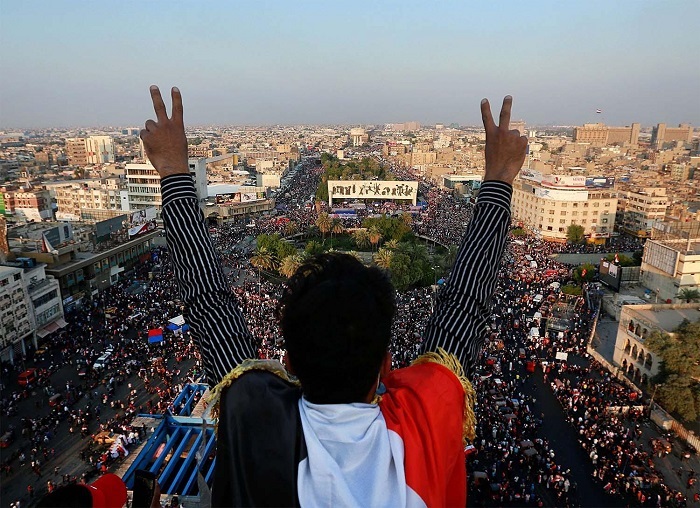Tahrir Square... a "Small Republic" at the heart of Baghdad

Shafaq News/ Tahrir Square in the center of the Iraqi capital Baghdad has become a small "republic" full of life.
Tahrir Square is the stronghold of the mass popular demonstrations demanding the "overthrow of the regime" on the background of the deteriorating living conditions, which entered last Friday its second month and resulted in the death of more than 250 people.
This arena played an important role in many of the revolutions, marches and uprisings in Baghdad.
It was called Tahrir Square in reference to freedom from occupation and foreign colonialism. It is decorated on the east side by the Monument of Freedom and al-Umma Garden.
Protesters from different segments of society are now in the arena.
Every group is doing a certain job. There are cooks, cleaners, doctors, Tuk Tuk drivers, and even an editorial library to read books for free.
Thousands of tents are set up by the protesters, mattresses and blankets are scattered around the square and floors of the abandoned Turkish restaurant building, where each group takes a corner to rest by smoking a hookah, while others play dominoes or cards or just lay down, despite the noise as protesters chant chants and sing songs about the fall of the ruling elites.
A group of middle-aged women making falafel sandwiches sat, young men and old people wandered around the square to sell some of the things they used to sell on the streets and tours.
On the walls and facades of buildings, hundreds of banners, from the demands of the demonstrators and pictures of those killed in the square, to slogans rejecting "quotas and division" as well as Iraqi flags.
The Turkish restaurant building has been transformed into a line of defense, in which the demonstrators are monitored and informed of the withdrawal of security and police officers and their mechanisms or their progress towards the demonstrators.
The building, which has become a temporary residence and a noisy center for protesters, overlooks al-Jumhuriya Bridge which is the only barrier between the protesters and the heavily fortified Green Zone, where government buildings and embassies are located, and the authorities fear they will storm.
The demonstrators set up checkpoints in the streets leading to Tahrir Square and its environs to redirect traffic and facilitate the movement of protesters.
Protesters called parts of the square and the surrounding streets the names of provinces and ministries such as the Ministry of Commerce and Supply, which is located in the "al-Umma province garden" and "Ministry of Defense" located within the province of the Turkish restaurant building.
Services are free
Mohammed Najm, a graduate of the Faculty of Engineering but unemployed, told "Reuters" that the scene has become a model for the country that he and his colleagues hope to build. "We clean the streets, others bring us water and provide us with electricity," he said.
"(The square) is a small country. Free health services and free transportation by Tuk Tuk that (became an ambulance, transport, supply and backbone). In 16 years, the government has not been able to achieve what we have achieved in seven days of liberation. They have to leave. "
Doctor, Samar, 44, said she was coming to Tahrir Square "to help our children (protesters) ..." She added: "No one else will help them. The Ministry of Health and our hospitals will not give us assistance to treat the wounded."
"In the current demonstrations, coordination has become better inside Tahrir Square, although it is spontaneous but organized," said Mohammed A., an Iraqi journalist.
He explained that the donations to the demonstrators are unprecedented as donation of water, food, medicine, clothing and even generators to light the square and "Mount Uhud" in reference to the Turkish restaurant building.
Ahmed Abbad, a 50-year-old demonstrator in the same square, said: "The first people who started carrying food and mattresses for the protesters were women. This was the beginning of turning the scene into a small republic.
He added to (Irfaa Sawtak): "Tahrir Square is everything in our lives today. Be or not to be for Iraq, my country is looted and I will continue to demonstrate and if I was killed , I want my country back."
From them the homeland is formed
The scene was the starting point for Iraqis at every demonstration and vigil, including the protest movement against the government of former Prime Minister ,Nuri al-Maliki in 2011.
Ahead of the last parliamentary elections in mid-last year, Tahrir Square witnessed protests calling for boycotting the elections.
Haider al-Iraqi, 39, was one of the demonstrators who went out to Tahrir Square two months before the elections.
"We went out at the time to call on the people to boycott the elections and the people responded to that call," he said.
"From Tahrir Square, the great homeland of Iraq is formed. Tahrir Square has become a shrine for many Iraqis, just like in Karbala."
In recent days, protests have accelerated, and Tahrir Square has drawn huge crowds from across Iraq's ethnic and sectarian lines to reject political parties that have been in power since 2003.
The demonstrators do not appear to be returning home any time soon.
"The people said it and one demand ... We will continue to demonstrate until the overthrow of the corrupt government," he said.